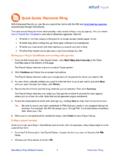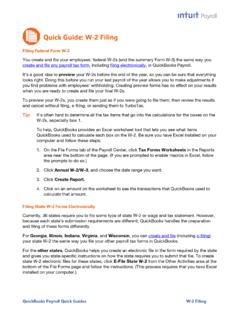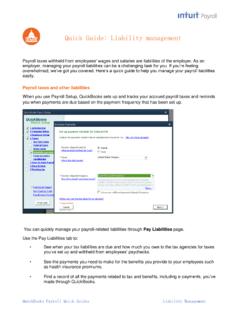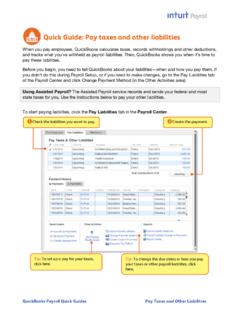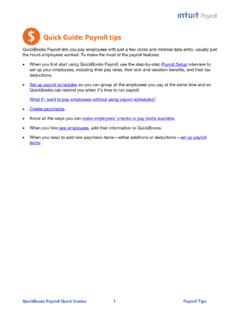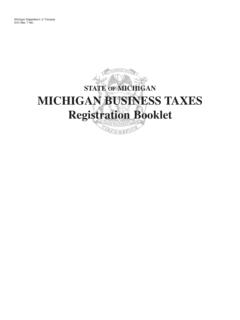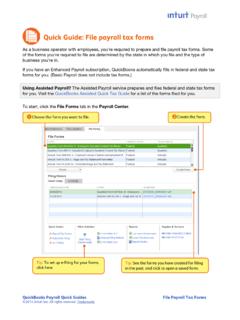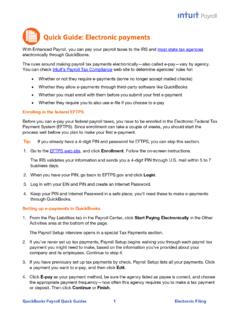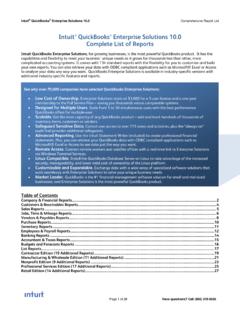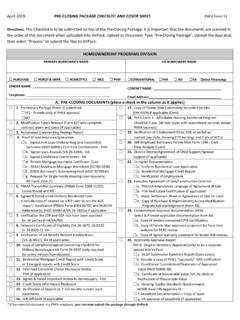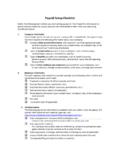Transcription of YTD Tax Checklist - Intuit
1 Tax Payments Checklist ( year to date Payroll) Important: Before you enter tax payments in the Enter Payroll Tax Payments window: Enter all your year to date paychecks in the Enter Paychecks window. Print this Tax Payments Checklist document and review it carefully. To enter tax payments correctly in Step 5 of Payroll Setup, follow these steps: 1. Understand tax payment concepts. 2. Gather your tax payment information. 3. Enter tax payments in Step 5 of Payroll Setup. 1. Understand tax payment concepts What is the Enter Payroll Tax Payments window? The Enter Payroll Tax Payments window in Step 5 of Payroll Setup lets you enter the payroll tax liabilities you've paid so far this year . QuickBooks uses this information to determine how much you still owe to federal and state agencies and to help ensure that your future tax deposits and filings are accurate. What is a payroll tax liability?
2 A payroll tax liability is money you owe a government agency for a payroll tax item. Some examples include: Federal or state withholding (also called Income Tax; does not include Social Security or Medicare) Social Security company paid tax (also called FICA or OASDI) Social Security employee paid tax Medicare company paid tax Medicare employee paid tax Federal Unemployment Tax (also called FUTA) State disability insurance (also called SDI) State unemployment insurance (also called SUI) State surcharges and assessments Any other local or custom taxes Tax Payments, year to date Payroll (9/4/2008) Page 1 of 8 What is a tax payment? A tax payment is an amount you paid to a federal or state agency to cover one or more payroll tax liabilities you owe that agency for a deposit period. The deposit is based on when the agency requires you to make the payments. How do you determine the breakdown of your payments?
3 You probably know how much you paid to federal and state tax agencies. Now you need to figure out how those payments are broken down into individual liabilities. Example: You made a tax payment to the US Treasury for $725 on 3/15/08. That $725 is 1 payment that is broken down into several liabilities: $ for Federal Withholding taxes + $ 75 for Medicare company and employee paid taxes* + $ for Social Security company and employee paid taxes ** TOTAL = $725 paid on 3/15/08 to US Treasury * $ for company paid portion, $ for employee paid portion **$ for company paid portion, $ for employee paid portion 2. Gather your tax payment information Where do you get this information? Depending on how you've managed your payroll, liability payment information may be available from several sources: Your accountant or tax professional Your payroll tax payment records such as: your ledger, checkbook, payment journal, a bank EFT payment confirmation Reports from your previous payroll service 1 Questions to ask yourself and your accountant: Did the payment to an agency cover multiple liabilities?
4 Oftentimes, when tax payments are going to the same agency, employers group those taxes into a single payment. When you enter your tax payments in QuickBooks, however, you must identify how much was paid toward each tax within the grouping. 1. If you're converting from a payroll service that combines FICA and Medicare on their reports, determine the split before you enter these amounts in Step 5 of Payroll Setup. Tax Payments, year to date Payroll (9/4/2008) Page 2 of 8 For example, the IRS typically requires that Federal Withholding, Social Security, and Medicare taxes be paid together as a single 941 tax payment. These payments are reflected in your Quarterly Form 941. Determine if you grouped your taxes into one payment, and what the breakdown of the payment was in other words, how much you paid toward each liability in the grouped payment. Determine if you made multiple payments for a liability at different times or in different groupings during a time period, such as during a month.
5 For example, you made 3 separate payments for Social Security on different dates. Determine what those separate payments were, the different check dates of the payments, and what the sum of the payments is. Was the payment for liabilities accrued in the quarter in which the payment was paid or was it for a past or future quarter? The payment date may fall in a different quarter than the quarter in which liabilities accrued. For example, you made a payment for Federal Withholding, Social Security, and Medicare taxes on January 14th, and you're a monthly depositor. In this case, the payment probably applies to December of the previous year , so does not even affect year to . date tax payments for the current year . Make sure you know for which time period a payment applies. The Enter Payroll Tax Payments window asks you to enter your payments per quarter. If you paid a liability in Q2, but it applies to Q1 payroll, you'll need to enter the payment in the Q1 section of the window.
6 Example Let's say you have a record of a monthly payment you made to a tax agency. What you need to know is which tax liabilities that payment went toward for example, how much of the 941/944 payment you made to the IRS went toward income tax withholding, Social Security, Medicare, and so on? To figure this out, get a detailed report from your accountant or previous payroll service that shows the exact breakdown of your payment to the IRS. In this example, you ran payroll on 3/01/2008 and accrued liabilities of $1, Your detailed report shows the breakdown of separate liabilities as follows: $ Federal Withholding $ Medicare Employee $ Social Security Employee $ Medicare Company $ Social Security Company $1, TOTAL PAYMENT ON 3/6/08 Tax Payments, year to date Payroll (9/4/2008) Page 3 of 8 Your report also tells you that you paid these liabilities to the IRS on 3/06/08 as a lump sum of $1, When you enter the information from this report in the Enter Payroll Tax Payments window, enter the payment amount for each separate liability (Federal Withholding, Medicare Employee, Medicare Company, Social Security Employee, Social Security Company), rather than the total payment of $1, If you made other payments during the quarter toward a liability, add up the payment amounts for the liability and enter the total for the quarter.
7 Remember to add up the payment amounts based on the payroll date they apply to, not based on the date of the check you sent to the agency. Tax Payments, year to date Payroll (9/4/2008) Page 4 of 8 3. Enter your tax payments in Step 5 of Payroll Setup 1. Print this Tax Payments Checklist document for easy reference. 2. As described in Gather your tax payment information: a. Gather your quarterly payroll records for the tax payments you made and the breakdowns of each. b. Add up the amounts of the breakdowns and figure out the total amount you paid for each liability in each quarter. Important: Again, most likely your accountant or previous payroll service has this information, so get it from them. 3. In the Enter Payroll Tax Payments window, look at the list of tax liabilities for each quarter and review the QuickBooks Calculated Amount. Based on the year to date paychecks you entered earlier in the Enter Paychecks window of Step 5, this is the amount that QuickBooks has determined you should have paid for each liability.
8 If the QuickBooks Calculated Amount doesn't match your tax records, double check the Enter Paychecks window to determine if you entered your paychecks correctly. Tax Payments, year to date Payroll (9/4/2008) Page 5 of 8 Important: You may not have paid these amounts yet, in which case your records don't match what's on the screen. Continue with this task anyway, as QuickBooks will ask you how much you've paid so far. 4. Next to each liability, in the Total Amount You've Already Paid column, enter the amount you determined you've already paid for that quarter's liability: 5. Or, if you made multiple payments for a single liability at different times or in different groupings during a quarter: a. Click the calculator icon in the Total Amount You've Already Paid field. Tax Payments, year to date Payroll (9/4/2008) Page 6 of 8 b. Enter the individual payments. c. Then click Save.
9 Note: You don't need to enter the payment dates. 6. Continue entering your payment information. The Balance Remaining field shows you what you still owe the federal or state agency for each liability. A positive amount in the Balance Remaining field indicates that you still owe the agency for the liability. Remember to make that payment by the agency due date . Assisted Payroll: Any balance remaining for current quarter payments is debited from your payroll service bank account as soon as you complete Step 6, Data Review, of Payroll Setup. Make sure at that time that your account has sufficient funds to cover this balance remaining amount. You are responsible for any penalties for current quarter payments that are past their due date . Tax Payments, year to date Payroll (9/4/2008) Page 7 of 8 A negative amount in the Balance Remaining field (in this example, for Medicare Company), could mean one of the following: You inadvertently entered an extra paycheck in the Enter Paychecks window, or an extra tax payment here in the Enter Tax Payments window.
10 You overpaid the tax and are due a credit for this liability. Important: If the amount in Balance Remaining doesn't match your tax records, double check the following information: Paychecks you entered earlier in the Enter Paychecks window of Step 5. Payroll items you set up earlier during Steps 3 and 4 of Payroll Setup. You may have incorrectly entered paychecks in Step 5, or incorrectly set up deductions and employees earlier the Payroll Setup interview. 7. After you've entered the payment amounts for all your liabilities in each quarter, click Done Entering Payments. Tax Payments, year to date Payroll (9/4/2008) Page 8 of 8
